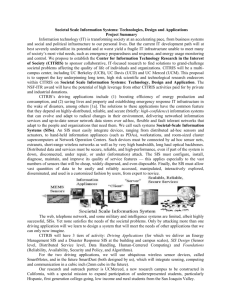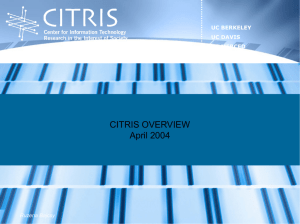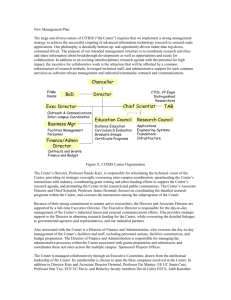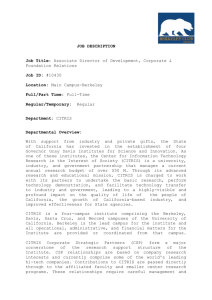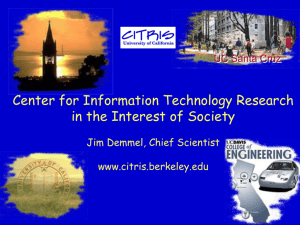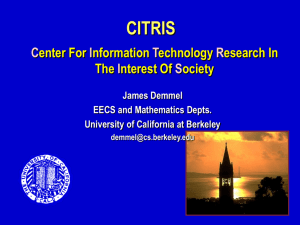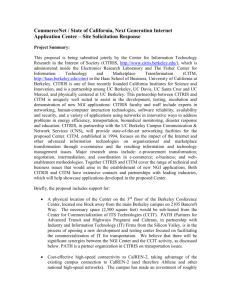BWRC + CITRIS
advertisement
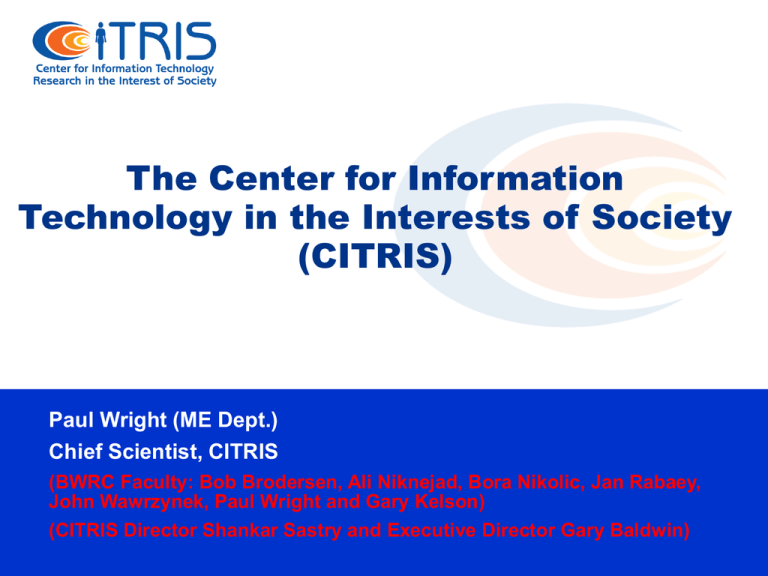
The Center for Information Technology in the Interests of Society (CITRIS) Paul Wright (ME Dept.) Chief Scientist, CITRIS (BWRC Faculty: Bob Brodersen, Ali Niknejad, Bora Nikolic, Jan Rabaey, John Wawrzynek, Paul Wright and Gary Kelson) (CITRIS Director Shankar Sastry and Executive Director Gary Baldwin) CITRIS mission CITRIS was created by the previous Governor’s initiative in ~2000 to bring new focus on societal scale challenges Four UC campuses are focused on applying IT to.. Intelligent Infrastructure Energy, water, earthquake preparedness, security… Health care and bio-medical services/products Services Science (especially encouraged by IBM) The center is funded by the State of California and industry A new building is presently under construction on our main campus … It will host major laboratories (including space for BWRC as needed) + a state of the art NanoFabrication Laboratory Wright BWRC/CITRIS 2 An example of a BWRC + CITRIS project Our prototype system balances occupant comfort vs. price preferences with automatic, reactive short-term load shedding and long-term energy reduction Utility RealTime Meter Price Signal Air Conditioner Disaggregation of Thermostat into Nodes, Control, Wright BWRC/CITRIS 3 Interface, and Communication Preference slider Founding Corporate Members Platinum Corporate Members Associate Corporate Members Wright BWRC/CITRIS 4 CITRIS Organizational Structure UC Chancellors C. Tomlinson-Keasey, UC Merced (Chair) Robert J. Birgeneau, UC Berkeley Denise D. Denton, UC Santa Cruz L. Vanderhoef, UC Davis CITRIS Executive Committee (Academic) CITRIS @ UC Berkeley Director – S. Shankar Sastry Executive Director- Gary Baldwin CITRIS @ UC Merced Campus Director – S. Shankar Sastry Chief Scientist - Paul Wright Campus Director - Jeffrey Wright Acting Chief Scientist – German Gavilan UC Berkeley UC Merced Wright BWRC/CITRIS 5 CITRIS @ UC Davis Campus Director – S.J. Ben Yoo UC Davis Institute Advisory Board (Industry) CITRIS @ UC Santa Cruz Campus Director - Patrick Mantey Chief Scientist - Alex Pang UC Santa Cruz What’s the difference between BWRC and CITRIS? CITRIS works with its affiliate centers – BWRC as a leading example --- towards commercial & social impact For BWRC supporters CITRIS provides an additional impact opportunity --- to “funnel” our basic core science (WSNs, UWB, 60GHz etc) into commerce, societal problems, and shifts in public policy No other CA organization brings the multi-disciplinary horsepower together, to focus on innovative technology “in the service of society,” like CITRIS CITRIS provides a unique “glue” and “roll-out opportunity” for seemingly disparate activities Wright BWRC/CITRIS 6 BWRC as a “feeder” to CITRIS Put in another way…. How is CITRIS different from BWRC… but how do the two operations work together? BWRC is in the “research business” of fundamental research in low power radios, UWB, >60GHz.. CITRIS is in the “research business” of applying these fundamental ideas to new products, new health services, energy efficiency, homeland security … Wright BWRC/CITRIS 7 BWRC as a “feeder” to CITRIS A BWRC thesis: “Ultra Low Power Transmitters for Wireless Sensor Networks,” The thesis proposed the design and optimization of nodes for wireless sensor networks with ultra low power, namely: consume less than 100 microwatts of average power for a long life; cost less than $1 for a low system cost; and occupy less than one cubic centimeter (Yuen Hui Chee) A CITRIS thesis: Wireless sensor networks for energy efficiency. This thesis reports on packet-level performance of 2.4GHz Telos wireless sensor nodes in residential environments. The objective is to characterize the packet loss to determine the necessity of mesh networking for residential wireless sensor networks. The results describe two deployments in four residential houses (Nate Ota) Wright BWRC/CITRIS 8 How we think about CITRIS projects… • • • • • • • • • If successful, how will it change the world? = Societal pull How will it use CITRIS technology/skills = “Tech. push” Does it leverage multi-campus CITRIS research teams? Are the metrics for success well-established? Has it passed competitive peer review: awarded federal or State funding? Can our corporate/federal/state sponsors find enough value to buy in? Are student initiatives (e.g., student clubs) represented? Sponsor international symposium in this area? Constantly strive for synergy among 4 (not 1) campuses and sponsors Wright BWRC/CITRIS 9 CITRIS project overview 1. Intelligent infrastructures Health Care Energy Water Infrastructure Natural disasters TIER Cyber-security TIER – (projects for the developing world) Services 2. Healthcare Implantable wireless sensors (BSN) Link to home-wireless IT services 3. Services: Science, Management, and Engineering Academic curriculum Research agenda Wright BWRC/CITRIS 10 1. BWRC + CITRIS = Intelligent infrastructures Energy Water Health Care Cyber-infrastructure Natural Disasters Transportation For intelligent infrastructures, BWRC/CITRIS provides the leverage for: Generic technology – hardware platforms (motes) shared by all… Common elements – low-power radios, sensors, MEMS-sensors, Common software – TinyDB, Deluge, Common labs Testbeds at Berkeley (Soda, Etcheverry, Cory, BWRC) Merced, Santa Cruz, Davis Common infrastructure is raising all boats Annual symposium on intelligent infrastructures planned Wright BWRC/CITRIS 11 1. BWRC + CITRIS = Intelligent infrastructures (also relates to California Governor’s proposal) 1950s and 1960s phenomenal investment in the state’s highways, ports, energy & water supply systems, schools and universities created the 6th largest economy in the world In 1955 the population was ~13 million but by 2025 it will be 46 million Older investments showing their age + expansion needs added resources Strategic growth plan ~$250b. – first 10/20 year effort Calls for “expanded authority to fund and deliver projects through a variety of public-private partnerships” Wright BWRC/CITRIS 12 1. BWRC + CITRIS = Intelligent infrastructures (five & ten years in billions of dollars) Topic First five Next five 1. Energy $ 25 billion …. 2. Transportation/Air quality $ 42.0 billion $ 65.0 billion K-12 Education $ 17.5 billion $ 30.7 billion Higher Education $ 5.4 billion $ 6.3 billion 3. Flood control and water supply $ 11.0 billion $ 24.0 billion 4. Public safety $ 8.1 billion $ 9.3 billion 5. Courts and other public service infrastructure $ 2.3 billion $ 1.0 billion Wright BWRC/CITRIS 13 2. BWRC + CITRIS = Health Care dollar opportunities Age We spend $ 2 T per year in health care (16% of GDP). 10 % of population over 60 expected to grow to 25 % by 2030. Huge opportunities to make a difference in continuous monitoring (tele-medicine) for chronic conditions, elder care. 85+ 80-84 75-79 70-74 65-69 60-64 55-59 50-54 45-49 40-44 35-39 30-34 25-29 20-24 15-19 10-14 5-9 0-4 1950 1980 2000 2030 (150,216,000) (227,658,000) (267,955,000) (304,807,000) Source: U. S. Census Wright BWRC/CITRIS 14 2. BWRC + CITRIS = Health Care dollar opportunities Implantables and wireless monitoring (see Jan’s talk) Exquisite Detection: presymptomatic detection of disease (BSAC leading the way with lab on a chip, bio-sensors,..) Use of EDA like methods to do open source analysis of gene-protein, protein-protein networks: Biospice, SynBio (joint with QB-3) Stem Cell Initiative and Tissue Engineering (including social, legal and ethical considerations) Wright BWRC/CITRIS 15 3. BWRC + CITRIS = Impact at “Service Layer” (using Health Care here as an example) What impact can mobile phones have on user health? Imperial College, Rifat Atun et al., Vodaphone (3.25.06) 150 examples of text messaging in health care delivery 1) Efficiency gains: reduce number of lost appointments (UK) 26-39% (GPs), 33-50% (Hospitals) = £256-364m. Savings 2) Public-health gains: hard to reach locations / also teenagers! WHO: India > Tuberculosis: Kenya, Nigeria, Mali > HIV&Malaria 3) Treatment regime: take medicine now! exercise! don’t smoke! Diabetes is a good example of this requiring constant management “Good” patients measure blood-sugar levels and inject insulin 3x/d V. Franklin (Dundee), “Sweet Talk” > Text messages to teenagers Increased “self-efficacy,” haemoglobin HbA1c was 14% lower Wright BWRC/CITRIS 16 Summary: BWRC + CITRIS Wright BWRC/CITRIS 17 Summary: BWRC >> CITRIS Adoption needs lower power radios & cheaper devices <100 mW integrated node Base Voltage Band Conv RF + Antenna Baseband (mixed-signal) 64K Clock memory Generation Locationing Engine Digital Processor(s) Sensors GPIO Serial InterfaceInterface DW8051 μc Neighbor System List Supervisor Network Queues DLL Power Supply Network • Simplest possible processor • Dedicated accelerators when needed • Aggressive power management • Minimizing supply voltage Courtesy: Mike Sheets Wright BWRC/CITRIS 18 Incoming price signals BWRC Low Power Radios in Demand Response in CA 1. New Thermostat with touchpad shows price of electricity in ¢/kWhr + expected monthly bill. *Automatic adjustment of HVAC price/comfort. *Appliance nodes glow-colors based on price. 2. New Meter conveys real-time usage, back to service provider 3. Wireless beacons throughout the house allow for fine grained comfort/control Wright BWRC/CITRIS 19 Appliance lights show price level & appliances powered-down
